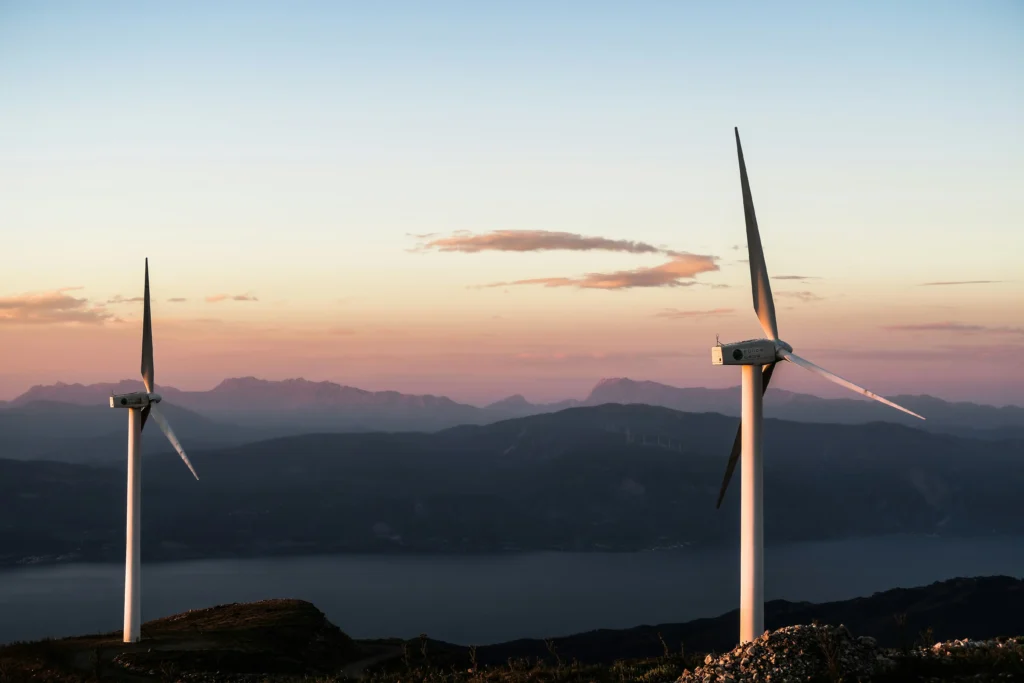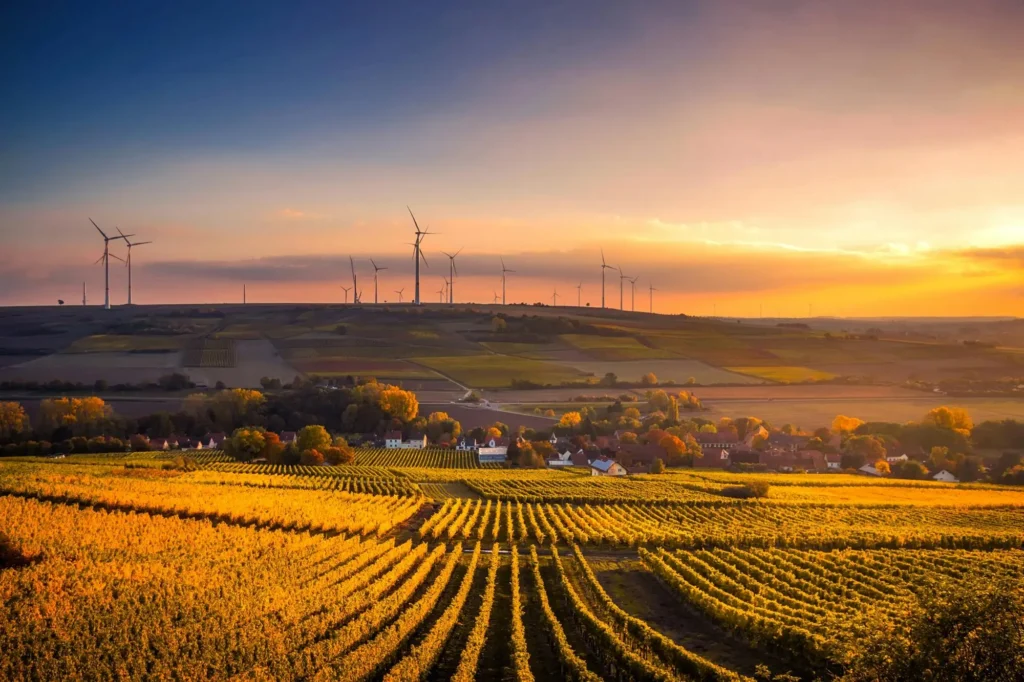
Environmental Impact of Wind Energy
Discover how wind energy impacts the environment
4 minute read • Last update June 2025

In this article
Wind farms generate a significant share of the power in the U.S., especially in states like Texas. Wind turbines offer a low-emission solution to meet rising energy needs, but wind energy also comes with environmental trade-offs that deserve attention.
From wildlife impacts to land use and lifecycle emissions, understanding the full scope of wind farm environmental impact is essential for policymakers, developers, and consumers alike.
10 ways wind energy impacts the environment
1. Wind farms generate electricity with zero emissions
One of the greatest advantages of wind energy is that it produces no air or water pollution during operation.
Unlike coal or natural gas, wind turbines do not emit greenhouse gases while generating electricity. This makes them a core part of decarbonization efforts.
2. Wind turbines have a low carbon footprint over their lifetime
While there are emissions associated with manufacturing and installing turbines, the operational phase offsets this quickly.
On average, wind turbines repay their carbon “debt” within 6 to 12 months and operate for 20+ years. Carbon debt refers to the time it takes for a wind turbine to generate enough clean electricity to offset the greenhouse gas emissions associated with its manufacture, installation, and decommissioning.
Several studies show the payback period falling within 6 to 12 months:
- This study finds that the average energy payback time for both turbines is 7 months (Tremeac & Meunier, 2009).
- Studies have worked out the payback period for offshore wind turbines to be from 6 to 12 months (Department of Climate Change, Energy, the Environment and Water, 2025).
With payback periods typically under a year, modern wind turbines offset their manufacturing and installation impacts quickly. This makes them one of the most efficient technologies for rapidly reducing lifecycle emissions.
3. Wind farms require large land areas, but not full use
Wind projects have a large physical footprint, but they don’t consume the land. Farmers and ranchers often continue using the land for crops or grazing between turbines. This makes wind energy compatible with agriculture.
For example, the Roscoe Wind Farm spans 100,000 acres of Texas land, 3 hours west of Fort Worth, but the land is also used for cotton and wheat farming.
4. Wind turbines can disrupt local ecosystems
Large-scale wind farms may disturb native habitats, fragment migration paths, or alter vegetation patterns. Site planning and environmental reviews are needed to minimize these impacts.
On-shore wind farms may impact local bats and birds, while off-shore farms may impact the marine animals that live in the surrounding area.
5. Wind turbines pose risks to birds, eagles, and bats
Collisions can occur, especially with raptors and migratory species. However, research shows other human structures (e.g., buildings, power lines) cause significantly more bird deaths. Emerging solutions include radar-triggered shutdowns and blade painting.
6. Wind farms create noise and visual disturbances
Wind turbines can produce audible noise and shadow flicker, which may affect nearby residents. Though rare, concerns about infrasound and health impacts persist despite limited scientific backing.
According to Energy.gov, wind turbine noise is created by the generator and by the “whooshing” sound of the blades rotating through the air. On average, land-based, utility-scale wind turbines can produce sound in the range of 35–45 dB heard from a distance of 300 meters away. This is as quiet as a refrigerator humming in the next room to the human ear.
7. Blade disposal and rare earth mining create lifecycle concerns
Decommissioned blades are difficult to recycle, and some turbines rely on rare earth minerals mined under questionable environmental conditions. The industry is working on biodegradable blades and improved recycling.
8. Wind power strengthens the local economy
Wind projects generate lease payments for landowners, create jobs in rural areas, and contribute to local tax revenues. Based on a University of Michigan case study, every 3 to 4 wind turbines (2.5 MW per turbine) will support roughly one full-time local job in operations, maintenance, or support services.
Beyond contributing to clean energy, wind farms stimulate onshore manufacturing and reinforce the U.S. renewable energy supply chain. According to the American Clean Power Association, wind developers paid approximately $706 million to landowners in 2019, averaging about $6,700 per megawatt (MW) annually. These lease payments typically combine fixed annual fees (e.g., per turbine or per MW) with revenue-based royalties, often starting in the 3–6% range of gross electricity revenue, and may include scheduled escalators over time, as outlined in a Kansas City Fed report. This structured compensation aligns landowner incentives with project success and supports sustained community investment.
9. Wind energy reduces dependence on imported fuels
Wind is a domestic, abundant resource which is a major pro for wind energy as a resource. Unlike fossil fuels, it isn’t vulnerable to price volatility or geopolitical risks. This enhances U.S. energy security while lowering long-term electricity costs.
10. Floating wind turbines will reshape offshore environmental dynamics
As wind energy moves offshore, floating wind turbines enable deployment in deeper waters beyond the reach of traditional fixed-bottom designs. This opens new capacity but raises important environmental questions. Potential concerns include disruption to marine habitats, seabed anchoring impacts, and noise pollution affecting aquatic species. However, floating systems can also reduce visual land impacts and avoid sensitive coastal ecosystems. As this technology scales, particularly in U.S. coastal regions like the Gulf of Mexico, balancing energy gains with ecosystem protections will be essential for responsible growth.
Floating wind turbines and hybrid systems (paired with solar or storage) represent the next frontier. With supportive policy and growing demand, the U.S., especially Texas, is set to expand wind generation dramatically.
Is wind energy right for Texas?
Texas leads the nation in wind generation, thanks to the favorable geography and market design in ERCOT. With continued investment in transmission infrastructure, wind energy will continue playing a major role in powering the state.
Written by Graham Lumley
Graham Lumley, Digital Marketing Manager at BKV Energy, leads digital and traditional marketing strategies, focusing on educating Texans about the state's deregulated energy market. With over 8 years of marketing experience, he creates content to help consumers understand and save on their energy bills, bringing a fresh and dynamic approach to the industry.
Related articles

How Much Wind Power Does Texas Generate?
8 minute readHow much wind energy does Texas produce? There are over 16,000 wind turbines in Texas capable of producing over 39,000
Get $50 off your electric bill!
Use code BKVEJOINUS50
Enter your zip code to shop BKV Energy's affordable, fixed-rate Texas electricity plans. Use the promo code for $50 off your electric bill.
